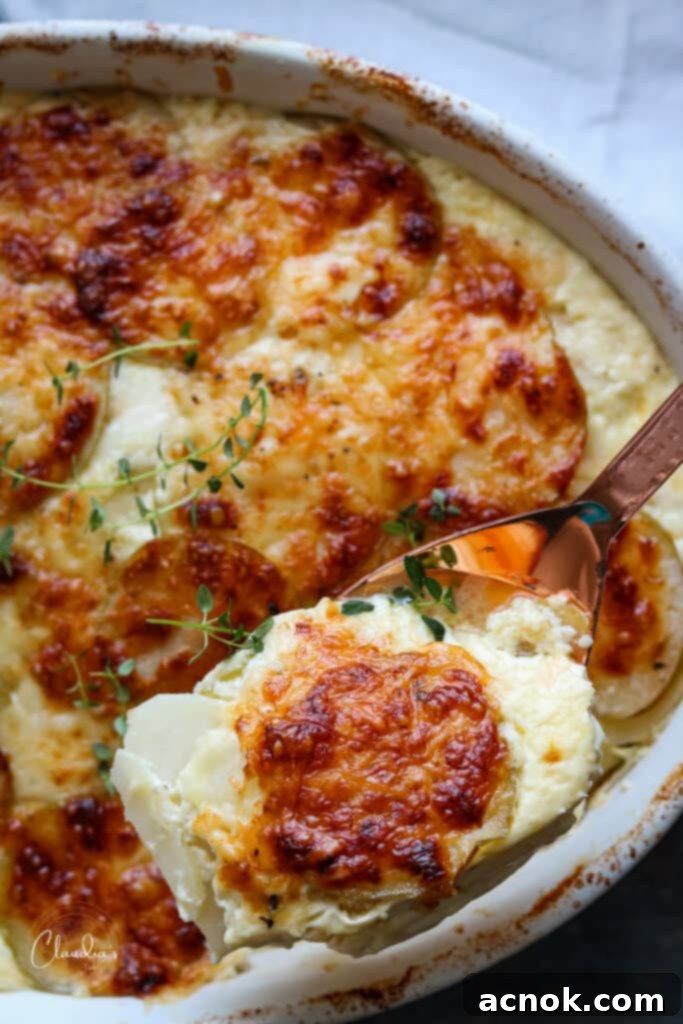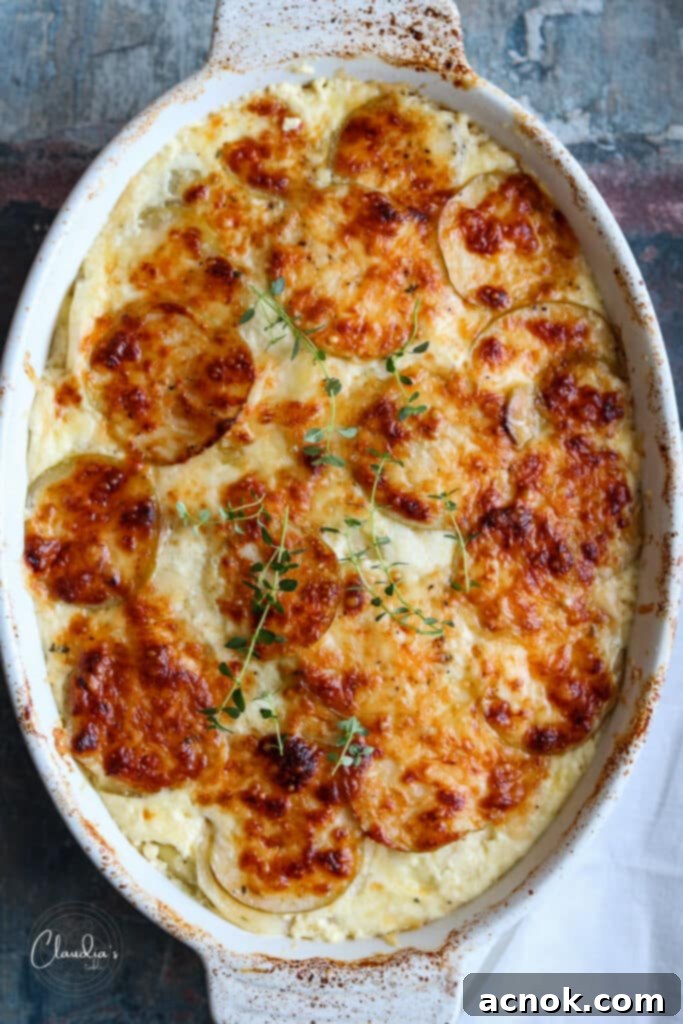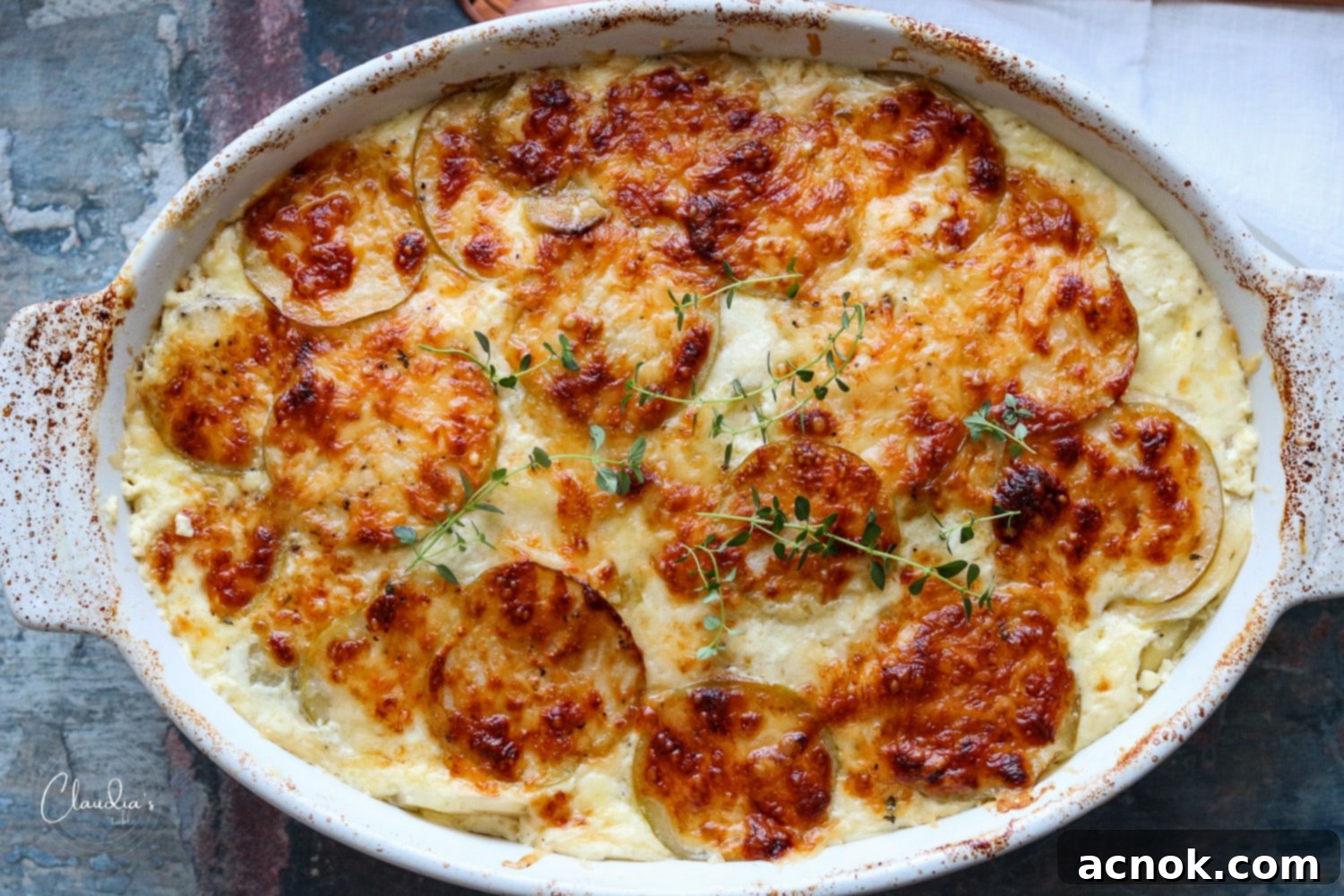The Ultimate Creamy Potato Apple Gratin: Your Perfect Holiday Side Dish
As the crisp air of Fall arrives and the festive season approaches, certain dishes simply become essential. This Potato Apple Gratin isn’t just a side dish; it’s a culinary celebration, a heartwarming staple that graces tables from Thanksgiving to Christmas, and every cozy gathering in between. It’s also an absolute showstopper for New Year’s Day brunch, consistently earning rave reviews and satisfying a crowd with generous servings. What makes this particular gratin so special? It’s the delightful addition of tart Granny Smith apples, the aromatic freshness of thyme, and the rich creaminess of Swiss cheese. While Gruyere, with its more intense nutty flavor, is a personal favorite, Swiss cheese provides a beautifully accessible and equally delicious alternative. The result is a truly unforgettable experience: creamy, tender layers of potato and melted cheese, perfectly contrasted by the bright, sharp notes of the apples and subtle, earthy undertones of fresh thyme. This dish doesn’t just taste exquisite; it looks stunning on any holiday table.

Table of contents
- What is Au Gratin Style Potatoes?
- What is the Difference between Gratin, Dauphinoise, and Scalloped Potatoes?
- Gratin or Au Gratin
- Dauphinoise
- Scalloped Potatoes
- Why Add Apples to Potato Gratin?
- Best Potatoes to Use for Potato Au Gratin
- Best Cheese for Potato Apple Gratin
- How to Make Potato Apple Gratin
- Tips for Perfect Slicing
- How to Assemble Potato Apple Gratin
- Baking and Finishing Your Gratin
- What Do I Serve with Potato Apple Gratin?
- How to Store Leftovers
What is Au Gratin Style Potatoes?
When you hear the term “Au Gratin Potatoes,” images of a rich, bubbling, cheesy potato casserole likely come to mind. It’s a dish we universally adore, often found on restaurant menus and holiday tables. But what does “au gratin” truly mean? Originating from French culinary tradition, “au gratin” literally translates to “by grating” or “with a crust.” In the culinary world, it refers to a technique where a dish is prepared with a browned crust, typically made of breadcrumbs, cheese, or both, which forms during baking or broiling. For this particular Potato Apple Gratin, the careful layering of ingredients and the extended baking time in the oven allow for the most exquisite golden-brown crust to develop naturally, rendering any additional broiling unnecessary. This method creates a deeply flavorful dish with a beautiful texture contrast – creamy and tender on the inside, with a wonderfully crisp and savory top layer. It’s the kind of irresistible side dish that has everyone asking for seconds!
What is the Difference between Gratin, Dauphinoise, and Scalloped Potatoes?
It’s easy to get these terms mixed up, as they all refer to delicious potato casseroles. The most commonly used terms are “Au Gratin” and “Scalloped Potatoes,” with “Dauphinoise” making an appearance now and then. While they share many similarities, there are subtle yet distinct differences that set them apart. Let’s explore these beloved potato preparations.
Gratin or Au Gratin
A classic Gratin, or Au Gratin, is characterized by its signature browned crust, as we discussed. It typically features layers of thinly sliced potatoes combined with a creamy liquid (often cream or milk, but in our recipe, we use buttermilk for a lighter tang) and, crucially, a generous amount of cheese. Breadcrumbs can sometimes be included to enhance the crust. The dish is usually topped with extra cheese before baking to achieve that irresistible golden, bubbly, and slightly crispy finish that is the hallmark of the au gratin style.
Dauphinoise
Potatoes Dauphinoise, often referred to simply as Gratin Dauphinoise, is a French potato dish that is quite similar to an au gratin. The key distinguishing factor traditionally lies in the preparation of the potatoes: Dauphinoise typically uses raw, thinly sliced potatoes, whereas a general au gratin might sometimes involve pre-cooked potatoes. Furthermore, a classic Gratin Dauphinoise often omits cheese in its purest form, focusing instead on the rich combination of potatoes baked in milk or cream, seasoned with garlic and nutmeg. However, modern interpretations frequently include cheese, blurring the lines and sometimes causing it to be described as “au gratin style.” So, while very close, the emphasis on raw potatoes and the traditional absence of cheese are the main historical differences.
Scalloped Potatoes
Scalloped potatoes are a tried-and-true American favorite, especially during the holidays. According to culinary traditions, this dish typically consists of thinly sliced potatoes baked in a simple, savory cream or milk sauce. The defining characteristic of traditional scalloped potatoes is the *absence* of cheese within the layers, although a cheesy topping is often added in many modern recipes, even acknowledged by publications like Southern Living. The focus is on the tender potatoes and the rich, comforting cream sauce, which bakes down to create a smooth and velvety texture. While less about the crispy top than au gratin, a well-made scalloped potato dish still develops a lovely golden hue on top from the baking process.
In a nutshell? All three are incredibly delicious ways to enjoy potatoes, offering comforting and crowd-pleasing side dishes. The hardest part is often deciding which one to serve!
Why Add Apples to Potato Gratin?
The inclusion of apples in this potato gratin might surprise some, but it’s a game-changer! Granny Smith apples, specifically, bring a wonderful tartness and firm texture that holds up beautifully during the baking process. Their crisp acidity cuts through the richness of the potatoes, cheese, and buttermilk, creating a balanced and incredibly flavorful profile. This unexpected combination adds a layer of complexity and freshness that elevates the dish beyond a typical potato gratin. The apples soften slightly, becoming tender but still offering a pleasant bite, while their natural sugars caramelize subtly, adding depth. It’s a delightful harmony of sweet, savory, and tangy notes that makes this gratin truly unique and irresistible.
Best Potatoes to Use for Potato Au Gratin
When you’re shopping for ingredients for this exquisite Potato Apple Gratin, look no further than good old russet potatoes. These versatile tubers are an absolute dream for gratins for several compelling reasons. Russets are known for their sturdy structure, which means they hold their shape perfectly under the heat of the oven, preventing the gratin from becoming a mushy mess. Their high starch content is another major advantage; as they cook, this starch releases, beautifully thickening the creamy buttermilk mixture and creating that dreamy, almost custardy texture that is so desirable in a gratin. Furthermore, russet potatoes have a relatively low moisture content, which also contributes to the dish’s overall creaminess without making it watery. And the best part? They are widely available and affordable, making this gourmet-tasting dish accessible to everyone. While other potatoes like Yukon Golds can work for a gratin, their waxier texture and lower starch content won’t yield the same melt-in-your-mouth creaminess as russets.
Best Cheese for Potato Apple Gratin
The cheese choice in your Potato Apple Gratin is paramount, as it forms the luscious, gooey backbone of the dish and contributes significantly to the final flavor profile. I’ve successfully made this gratin with both Gruyere and Swiss cheese, and both yield fantastic results. Gruyere, a semi-hard Swiss cheese, is known for its distinct nutty, earthy, and slightly sweet flavor with a rich, complex aroma. It melts beautifully, creating a wonderfully smooth and stretchy texture. It is indeed the sharper, more expensive cousin to standard Swiss cheese, and if you want to elevate this dish to a truly gourmet experience, a splurge on Gruyere is highly recommended – it absolutely will not disappoint! For the best flavor and texture, I always recommend buying blocks of cheese from the deli counter and shredding it yourself. Pre-shredded cheeses often contain anti-caking agents that can affect how smoothly they melt. If Gruyere is hard to find or outside your budget, a good quality Swiss cheese is an excellent alternative, offering a milder, buttery, and slightly sweet profile that still melts wonderfully and complements the apples and potatoes beautifully. Beyond these, other sharp cheeses like white cheddar, Asiago, or even a good quality plain sharp cheddar can work very well. When selecting your cheese, consider how its flavor will interact with the crisp, tart notes of the Granny Smith apples. A sharp or nutty cheese typically provides an excellent counterpoint to the fruit.
How to Make Potato Apple Gratin
Despite its impressive appearance and rich flavors, this Potato Apple Gratin is surprisingly one of the easiest recipes to prepare, especially when you’re cooking for a crowd. The key to its simplicity lies in efficient preparation, particularly when it comes to slicing the potatoes and apples. While a food processor or mandoline slicer will significantly speed up this process, don’t worry if you don’t have one; a sharp knife and a little patience will work just as well.
First, preheat your oven to 400°F (200°C). Then, prepare a large casserole dish, ideally a 3 1/2qt or slightly larger one, by spraying it generously with a nonstick cooking spray. This will ensure your gratin comes out easily and looks perfect. Set the prepared dish aside.
Next, let’s tackle the cheese. If you’re shredding your own, start by shredding one pound of Swiss cheese (or Gruyere, if you’re splurging) and grating a quarter-pound of Parmesan cheese. The freshly shredded cheese melts more smoothly and offers superior flavor. Set both aside.
In a medium-sized bowl, whisk together the three fresh eggs, three cups of buttermilk, two tablespoons of fresh chopped thyme leaves, two teaspoons of Kosher salt, and a half teaspoon of ground black pepper until thoroughly combined. This flavorful liquid will infuse every layer of your gratin with rich taste and moisture. Set this mixture aside.
Tips for Perfect Slicing
Consistent slicing is crucial for an evenly cooked and beautifully presented gratin. If you’re using a mandoline, set it to a precise 1/8-inch thickness. Wash and peel your russet potatoes. Carefully, and always with caution if using a mandoline, slice them into thin, uniform rounds. If you’re using a knife, take your time to slice them as thinly and consistently as possible, aiming for that 1/8-inch thickness. Once all the potatoes are sliced, set them aside.
Now, for the apples! Wash and dry your Granny Smith apples thoroughly. If using a mandoline, maintain the 1/8-inch thickness setting. Slice each apple in half, then remove the core and stems. Slice the apple halves thinly, again aiming for about 1/8-inch thickness. Don’t worry if some slices are larger than others; I often cut around the core, which naturally results in a few smaller pieces alongside the larger ones. This variation in size won’t affect the dish’s taste or texture in any way. If you don’t have a mandoline, simply slice them thinly by hand with a sharp knife, just like the potatoes.
How to Assemble Potato Apple Gratin
Assembling the gratin is where the magic truly begins. In your prepared large casserole dish, start by arranging a layer of thinly sliced potatoes on the bottom, overlapping them slightly to create an even base. This provides the foundation for your delicious gratin. Next, cover the potato layer with a layer of thinly sliced apples. Generously sprinkle one-third of your shredded Swiss cheese and one-third of your grated Parmesan cheese over the apples. Finally, pour one-third of the whisked egg and buttermilk mixture evenly over the cheese and fruit. Repeat this layering process twice more: another layer of potatoes, followed by apples, then the remaining one-third of the cheeses, and finally the last one-third of the egg mixture. This meticulous layering ensures every bite is packed with flavor and creamy goodness. Your gratin is now ready for the oven!
Pro Tip: To prevent the melting cheese from sticking to the foil during baking, place a piece of parchment paper directly over the potato mixture before covering the casserole dish with foil. This clever trick not only saves your delicious cheese but also helps maintain the gratin’s beautiful presentation.
Baking and Finishing Your Gratin
Bake the covered casserole for 1 hour and 15 minutes. This initial baking period allows the potatoes and apples to soften perfectly in the rich, creamy sauce. After this time, carefully remove the casserole from the oven. Discard the foil and parchment paper, then return the uncovered gratin to the oven for another 15-20 minutes, or until the top is beautifully golden brown and the potatoes are fork-tender. The surface should be bubbling and irresistible. Once baked to perfection, allow the gratin to set for about 15 minutes before serving. This brief resting period helps the layers firm up slightly, making it easier to serve clean, beautiful portions. This versatile casserole can be served warm, straight from the oven, or enjoyed at room temperature, making it ideal for holiday buffets.
Make-Ahead Tip: To simplify your holiday meal preparation, this casserole can be assembled up to 6 hours prior to baking. Simply prepare it as directed, cover it tightly, and place it in the refrigerator. Remember to remove it from the refrigerator about 20 minutes before baking to allow it to come closer to room temperature, which helps ensure even cooking.

What Do I Serve with Potato Apple Gratin?
The beauty of this Potato Apple Gratin lies in its incredible versatility. Its rich, creamy, and slightly tangy profile makes it an exceptional pairing for a wide array of main courses, particularly during the holiday season. For a comforting Sunday dinner, it pairs exquisitely with my Simple Herb Roast Chicken. If you’re looking for something more substantial, a large cut of beef like a Two-Ingredient Grilled Tri-tip Roast would be an absolutely amazing complement. And of course, it’s a quintessential addition to any Thanksgiving feast, standing proudly alongside an Oven Roasted Herbed Turkey Breast. Beyond these, consider serving it with simply baked chicken breasts or thighs, succulent pork chops, a festive holiday ham, or a classic pork roast. Its creamy texture and balanced flavors ensure it harmonizes beautifully with a variety of meats, making it the perfect side dish for any occasion.
How to Store Leftovers
Should you be fortunate enough to have any leftovers of this delectable gratin – a rare occurrence, as it tends to disappear quickly! – you’ll be pleased to know that this casserole freezes beautifully, allowing you to enjoy its comforting flavors another time. I often prepare a large batch specifically for this purpose, cutting the cooled gratin into individual fourths or smaller portions before freezing them in airtight plastic bags or containers. This makes future meal prep incredibly convenient.
To reheat frozen portions, preheat your oven to 375°F (190°C). Place the frozen Potato Apple Gratin in a casserole dish or a small oven-safe Dutch oven with a lid. Cover it and heat for approximately 45 minutes, or until it’s completely heated through and bubbling around the edges. For refrigerated leftovers, the reheating process is quicker; use the same method but bake for about 20 minutes, or until the gratin is thoroughly warmed and bubbly. In the refrigerator, this Potato Apple Gratin will maintain its quality and deliciousness for about 3 days. It’s a dish that truly keeps on giving!
Enjoy every delightful bite!
If you tried this recipe, please help other readers by commenting below and sharing some stars! We 🫶🏼 appreciate you!
All content and photographs ©Claudia’s Table and claudiastable.com

Potato Apple Gratin
Ana | Claudia’s Table
November 2, 2022
Pin Recipe
Equipment
-
1 casserole dish 3 1/2 – 4 qt size
-
mandolin slicer optional, for thin slices
-
cheese grater optional, for fresh cheese
-
medium bowl
-
whisk
Ingredients
- 2 lbs potatoes, baking like Russet potatoes, peeled and thinly sliced
- 2 lbs apples, unpeeled Granny Smith recommended, thinly sliced, cores removed
- 1 lb Swiss cheese, Gruyere or mild cheddar freshly shredded for best results
- 1/4 lb Parmesan cheese freshly grated
- 3 eggs large, fresh
- 3 cups Buttermilk
- 2 tbsp Thyme, chopped Fresh, leaves only, finely chopped
- 2 tsp salt Kosher or sea salt
- 1/2 tsp pepper freshly ground black pepper
- Thyme sprigs for garnish, optional
Instructions
-
Preheat your oven to 400°F (200°C).
-
Prepare a large casserole dish (3 1/2qt or slightly larger) by spraying it thoroughly with nonstick cooking spray. Set aside.
-
If you are shredding cheese from a block, start by shredding 1 pound of Swiss (or Gruyere/cheddar) cheese and grating 1/4 pound of Parmesan cheese. Set both aside.
-
In a medium bowl, whisk together the buttermilk, eggs, fresh thyme leaves, salt, and pepper until well combined. Set this liquid mixture aside.
-
Wash and peel the russet potatoes. Using a mandoline slicer (set to 1/8-inch thickness for best results) or a sharp knife, carefully slice the potatoes into thin, uniform rounds. Set the sliced potatoes aside.
-
Wash and dry the Granny Smith apples. Slice each apple in half, then remove the core and stems. Using a mandoline (1/8-inch thickness) or a knife, thinly slice the apples. It’s okay if some pieces are smaller after cutting around the core.
-
To assemble the gratin: In your prepared casserole dish, arrange an overlapping layer of sliced potatoes on the bottom. Top with a layer of sliced apples. Sprinkle 1/3 of the shredded Swiss cheese and 1/3 of the grated Parmesan cheese evenly over the apples. Pour 1/3 of the egg and buttermilk mixture over the cheese and fruit. Repeat this layering process twice more, creating three distinct layers of potatoes, apples, cheeses, and liquid.
-
Tip: Place a piece of parchment paper directly over the layered gratin before covering the casserole dish tightly with aluminum foil. This prevents the cheese from sticking to the foil as it melts.
-
Bake the covered gratin for 1 hour and 15 minutes. After this time, carefully remove the casserole from the oven, remove and discard the foil and parchment paper. Return the uncovered gratin to the oven and bake for an additional 15-20 minutes, or until the top is golden brown and bubbly, and the potatoes are tender when pierced with a fork.
-
Allow the gratin to rest for about 15 minutes before serving. This helps the layers set and makes for easier, cleaner serving.
-
This versatile casserole can be served warm or at room temperature.
-
Make-Ahead Tip: You can assemble this casserole up to 6 hours before baking. Cover tightly and refrigerate. Remove from the refrigerator 20 minutes before baking to allow it to come closer to room temperature.
Notes
Recipe adapted from Real Simple 2006.
Nutrition
Nutritional information is calculated online and should be used as a guide.
All content and photographs ©Claudia’s Table and claudiastable.com
- Pasta with Grilled Vegetables, Feta, and Lemon
- Grilled Asian Marinated Flank Steak
- Classic Homemade Chunky Blue Cheese Dressing
- 3-Ingredient Crispy Oven-Roasted Potatoes
- Grilled Peach Avocado Chicken Salad
